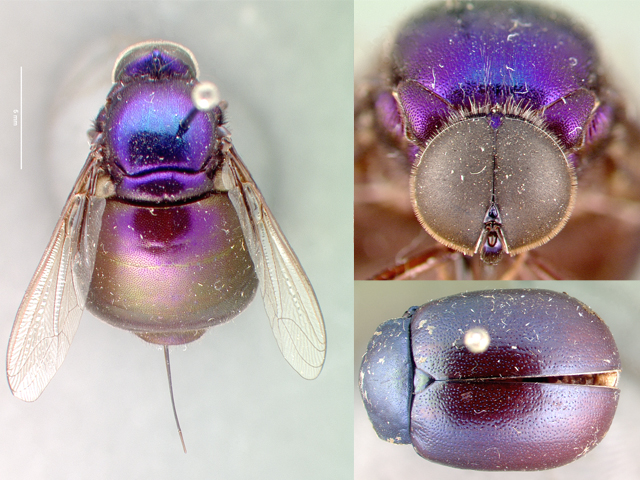대부분의 경우 파리는 내가 지나치게 흥분하는 곤충이 아닙니다.. 그러나, 수수께끼의 가족 Acroceridae는 예외입니다. 나는 때때로 흥미로운 속을 공유하기 시작할 것입니다 – 가족의 형태는 놀랍도록 다양합니다.. Most of my days are spent at the museum inventorying our massive collection of over 16,000 Acorcerids (aka small-headed flies). That may not sound all too impressive when you compare it to other more abundant families (and it does pale in comparison to the over 17,500,000 other specimens we do have in the museum); but it turns out to represent many, if not most, 의 모든 known specimens for the entire family. While there are likely large assemblages of these flies in other institutions, the California Academy of Sciences can easily claim the record ever since receiving the collection of Dr. Evert I. Schlinger (who occasionally comes in to work from the museum).
Acrocerids turn out to be a rather difficult group to study because of how rare they are in nature, their parasitoid biology, and how difficult they can be to catch on the wing. Their large thorax is packed with muscles that rocket the fly through the air – so if you don’t catch them at a flower you’re left longing for a Malaise trap. Ev did tell me one story of learning to catch these on the wing in Costa Rica. You stand downwind from a colleague in the field – as soon as someone hears something zip past, you swing wildly hoping to snare the fly by chance… it does work every once in a while. 이 파리는 또한 성체 거미의 유일한 내부 기생충으로 알려져 있습니다. (Tachinid의 기록이있을 수 있습니다…). 위의 속, 네오라시아, Theraphosid tarantulas의 기생충입니다. (뭔가 아포노펠마). 유충처럼 파리는 거미의 다리 위로 올라가서 복부로 파고들어가 책 폐 옆에 정착하고 작은 호흡 구멍을 냅니다.. 그런 다음 거미가 거의 성숙할 때까지 참을성 있게 기다립니다.. 암컷 타란툴라와 함께, 파리는 수십 년 동안 휴면 상태가 될 수 있습니다.. 결국 영화 Aliens와 유사한 일이 발생하고 유충이 거미의 내부 장기를 먹고 번데기로 나타납니다.. 그러나 거미가 기생충을 가지고 있는지 여부를 알아내는 것은 해부 없이는 불가능합니다 – 따라서 호스트 기록을 얻으려면 살아있는 거미의 대규모 컬렉션을 유지 관리해야 합니다.. Parasitoid biology is just so cool.
The above specimen (라시아 클레티 a new, unnamed, 종) was collected in 1977 by Schlinger near the town of Alamos, 멕시코 – on flowers with the likely mimic model, a Chrysomelidae beetle (beetle people, any ideas beyond family?).


Very interesting! Out of curiosity, because you mention large collections of live spiders, has any researcher reached out to the hobby tarantula keepers in a quest for specimens? While I have never seen something as spectacular as the above emerge from a wild caught tarantula, I have heard from a few people who ended up with “strange” flies in the past…
Reaching out to them for actual tarantulas has lead to quite a few specimens for Brent Hendrixson on his revision of the genus Aphonopelma, at least for the USA native species. There also are frequently imports of various species brought in from Central and South America, which is not a practice I like or am comfortable with…but it might lead to at least a few specimens given the numbers involved. Just a thought.
I think the answer is somewhat. I’ve reached out on message boards and even recently gave a short talk to the SF Bay Area Tarantula Society. The problem comes down to peoples immediate response when they see a giant grub crawling out of their spider – they reach in and grab their prize specimen and in the process damage the larvae or pupae of the emerging fly. As it turns out these flies are pretty sensitive before pupating and while I’ve seen lots of maggot images, never seen a fly reared by a hobbyist. I think the biggest hurdle is that people only discover what they are after they have had a spider die – and chances are it’ll be years before another one of their wild caught immature spiders are parasitized!
That makes a lot of sense, I guess it didnt really occur to me that for most people having a parasite emerge from one of their captives is a bad thing…that sort of thing would make my day. 🙂
Especially if that spider cost you a few hundred dollars!!
I wonder if that fly sees very well. 🙂
First impression of the beetle is a species of Chrysolina (subfamily Chrysomelinae), but my knowledge of Neotropical chrysos is limited.
Thanks for the genus ballpark – I’ll have to dig through our collections here to see if I can’t narrow it down more.
Did you mean that these acrocerid flies are the only known dipteran endoparasites of adult spiders? There are certainly spider-parasitic nematodes, and mantidfly larvae can crawl into the book lungs of their spider hosts and feed on hemolymph while hitching a ride to the egg deposition site.
http://en.wikipedia.org/wiki/Mantispidae
And here’s a cool post about a mantidfly larva on a spider, preserved in amber!
http://blogs.discovermagazine.com/notrocketscience/2011/03/28/spider-boarding-insect-preserved-in-amber/
(물론 이죠, that one’s on the outside of the spider, but the post also has more info on other tactics.)
Thank you for pointing that out! You’re correct of course, when I was thinking “no other endoparasitoids” I totally neglected non-insects such as nematodes. I should have recalled how tricky it can be to control nematode infestations in captive bread spiders!
I also did not know that about mantidflies. Actually I should catch up on the literature, there may be other diptera or hymenoptera parasitoids more recently known. Very cool, thanks for the link.
Augh augh augh and here’s a picture of a huuuuuge nematode coming out of a spider! It’s even one of the behavior-modifying parasites — it induces its host to seek out water before dying, so the nematode can complete its life cycle. (Like the horsehair worm in crickets!)
http://www.abc.net.au/science/k2/stn/spider.htm